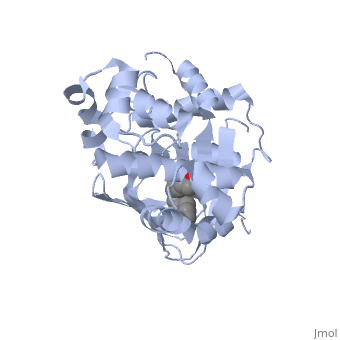ToxT
From Proteopedia
| Line 18: | Line 18: | ||
</StructureSection> | </StructureSection> | ||
==Further Study== | ==Further Study== | ||
| - | Conclusive results about what activates ToxT itself has not yet been found. The varying activity of ToxT dependent on the presence of <i>cis</i>-palmitoleate or other unsaturated fatty acids represents a detailed method of effective pathogenicity in humans, but may not be a reasonable target for drug treatment. By restricting transcription (and thus translation and protein production) of virulence genes until the bacterium is determined to be in a favorable location for infection, <i>Vibrio cholerae</i> avoids wasting energy producing virulence factors that will just be cleared by the intestine. This is a specific mechanism to ensure that the bacterium also injects CT and TCP where they will do the most damage, resulting in an infection. <ref> | + | Conclusive results about what activates ToxT itself has not yet been found. The varying activity of ToxT dependent on the presence of <i>cis</i>-palmitoleate or other unsaturated fatty acids represents a detailed method of effective pathogenicity in humans, but may not be a reasonable target for drug treatment. By restricting transcription (and thus translation and protein production) of virulence genes until the bacterium is determined to be in a favorable location for infection, <i>Vibrio cholerae</i> avoids wasting energy producing virulence factors that will just be cleared by the intestine. This is a specific mechanism to ensure that the bacterium also injects CT and TCP where they will do the most damage, resulting in an infection. <ref>Kenneth Todar [http://www.textbookofbacteriology.net/cholera.html] ''Vibrio cholerae'' and Asiatic Cholera, Todar's Online Textbook of Bacteriology. Accessdate=2011-11-29.</ref> |
==References== | ==References== | ||
<references/> | <references/> | ||
Revision as of 18:44, 29 November 2011
The crystal structure of ToxT is resolved in monomeric form, after isolation from Vibrio cholerae strain O395.[1]
Introduction
ToxT is a molecule at the end of a transcriptional cascade that autoregulates the transcription of the primary virulence factors of Vibrio cholerae[2] and itself. These two factors, cholera toxin (CT)[3] and the toxin co-regulated pilus (TCP), are instrumental in causing the disease cholera[4]. This is an intestinal infection resulting in massive water loss in the affected individual, causing extreme dehydration.[5]
| |||||||||||
Further Study
Conclusive results about what activates ToxT itself has not yet been found. The varying activity of ToxT dependent on the presence of cis-palmitoleate or other unsaturated fatty acids represents a detailed method of effective pathogenicity in humans, but may not be a reasonable target for drug treatment. By restricting transcription (and thus translation and protein production) of virulence genes until the bacterium is determined to be in a favorable location for infection, Vibrio cholerae avoids wasting energy producing virulence factors that will just be cleared by the intestine. This is a specific mechanism to ensure that the bacterium also injects CT and TCP where they will do the most damage, resulting in an infection. [5]
References
- ↑ 1.0 1.1 1.2 1.3 1.4 1.5 1.6 1.7 Lowden MJ, Skorupski K, Pellegrini M, Chiorazzo MG, Taylor RK, Kull FJ. Structure of Vibrio cholerae ToxT reveals a mechanism for fatty acid regulation of virulence genes. Proc Natl Acad Sci U S A. 2010 Feb 16;107(7):2860-5. Epub 2010 Feb 1. PMID:20133655
- ↑ Martin RG, Rosner JL. The AraC transcriptional activators. Curr Opin Microbiol. 2001 Apr;4(2):132-7. PMID:11282467
- ↑ Weber GG, Klose KE. The complexity of ToxT-dependent transcription in Vibrio cholerae. Indian J Med Res. 2011 Feb;133(2):201-6. PMID:21415495
- ↑ Shakhnovich EA, Hung DT, Pierson E, Lee K, Mekalanos JJ. Virstatin inhibits dimerization of the transcriptional activator ToxT. Proc Natl Acad Sci U S A. 2007 Feb 13;104(7):2372-7. Epub 2007 Feb 5. PMID:17283330 doi:10.1073/pnas.0611643104
- ↑ Kenneth Todar [1] Vibrio cholerae and Asiatic Cholera, Todar's Online Textbook of Bacteriology. Accessdate=2011-11-29.
Proteopedia Page Contributors and Editors (what is this?)
Ingrid Youngworth, Yang Yang, Michal Harel, Alexander Berchansky, Jaime Prilusky

